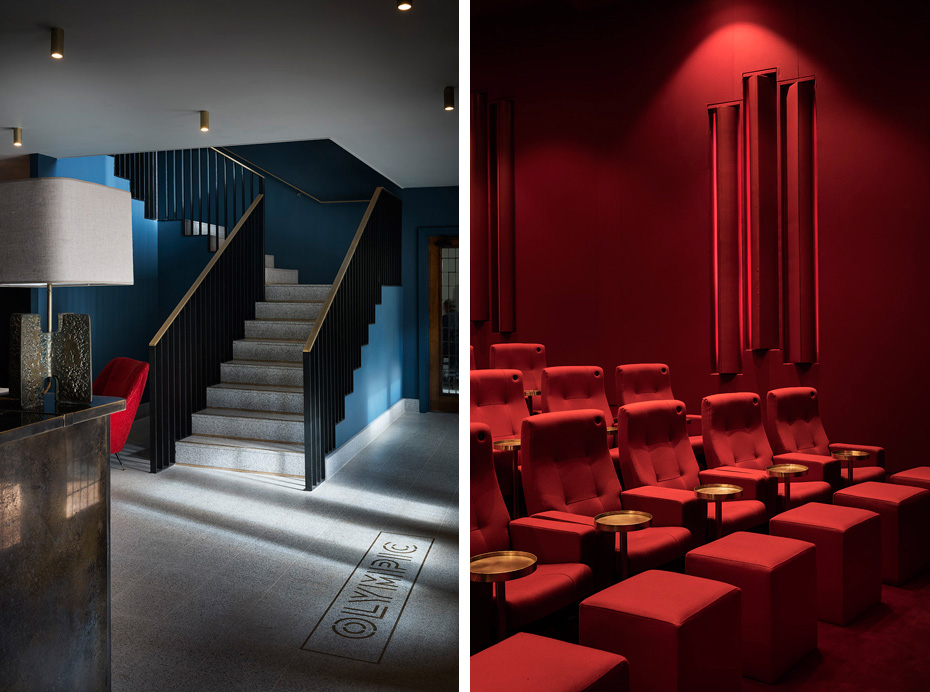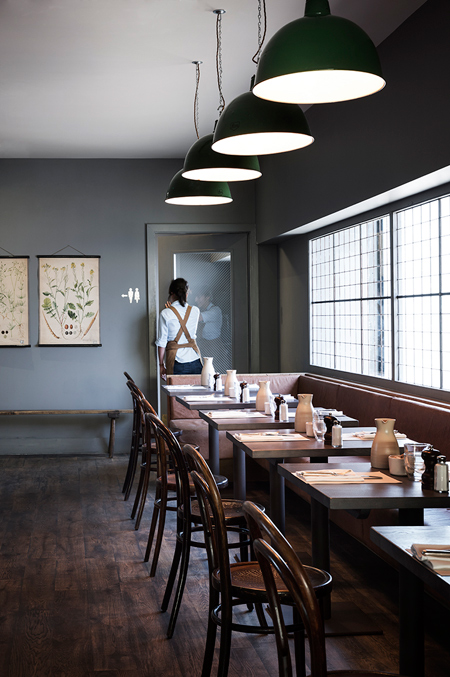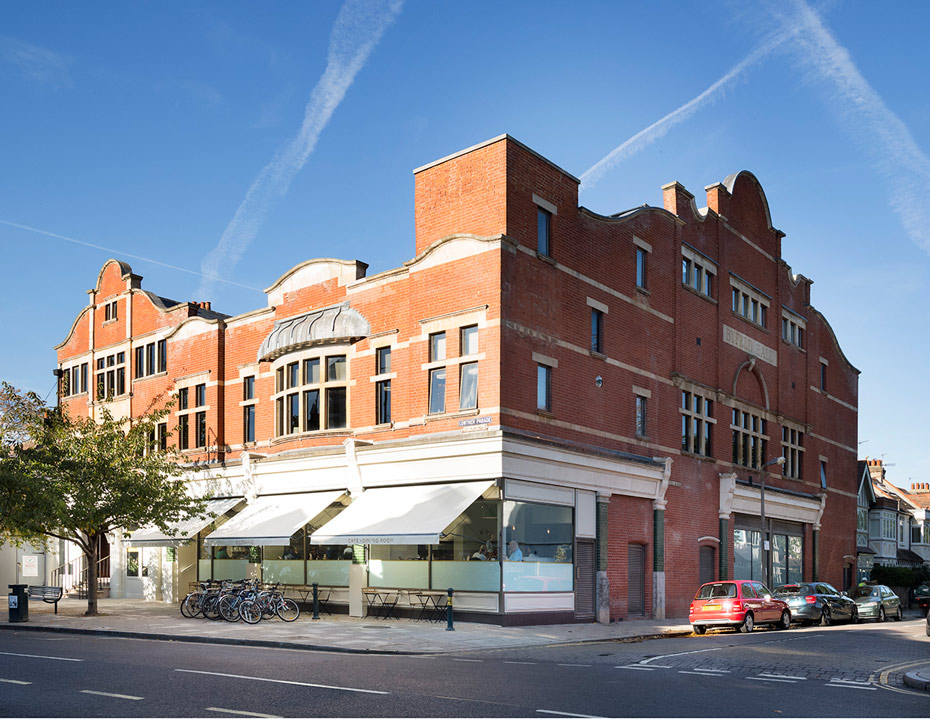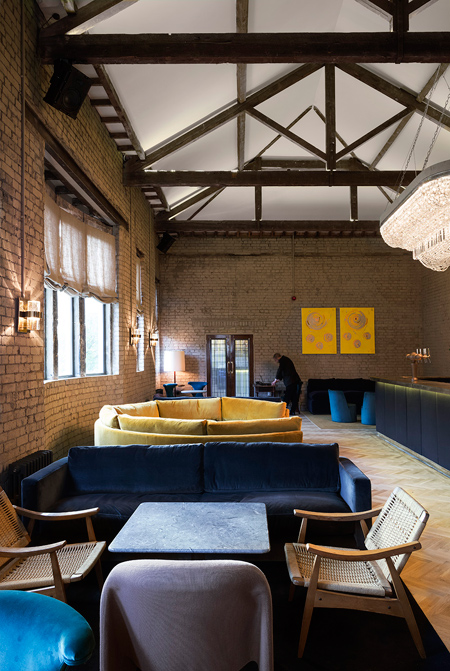
Above left: Lobby stairs, Above right: cinema three
As a recording studio, The Rolling Stones, The Beatles and Jimi Hendrix all recorded there – now a cinema, it’s serving the community of Barnes, London. We find out how interior design consultant Simone McEwan revisited its past to find inspiration for its future…
The Olympic Studios reopened its doors to the public for the first time in nearly 30 years in November as a new, independently owned community hub for film and music enthusiasts. Owned by graphic designers Lisa and Stephen Burdge, the building has been refitted as a state of the art cinema (complete with the only 3D cinema sound system in London), café and restaurant, and a member’s club lounge which takes its influence from Jean Luc Godard’s 1968 Rolling Stones documentary Sympathy For The Devil, filmed in the recording studio made famous by The Stones, Jimi Hendrix and The Beatles.
We spoke to interior designer and consultant Simone McEwan about working with the building’s rich cultural heritage to create an interior aesthetic that spoke to the building’s past whilst preparing it for a new generation of users.
How did you meet the challenge of creating interiors that were both sympathetic to the site’s historical heritage (and it’s cultural legacy as a recording studio), whilst simultaneously re-inventing it?
The building was empty when the current owners purchased it 5 years ago. Olympic Studios was originally built as a performance space in 1910, and had always been used for the purposes of entertainment (most famously as a recording studio for The Stones and Jimi Hendrix in the 60s), but over the years, layers had been added to the interior space onto the architectural structure of the building: every room was half the size it is today as they had so much sound insulation.

Back dining Room
The current owners ripped it all out so they could get a feeling of the space. There was pretty much no record of what was there originally – we did a lot of research to find images, even archives, of the interior and all we could find was the exterior.
So it was created from a blank canvas?
Pretty much. I didn’t do anything ‘pastiche’. We had to reintroduce everything: floors, walls surfaces – the starting point for the design was to imagine how do we do this in a simplistic way that’s sensitive to the building, without making it look fake and hideous.
How did you do this?
Every tiny little bit relating to the building’s history we could find, we’ve kept. For example, the wall cladding in the main auditorium space, which was part of the 1960s/70s soundwall system they used, an old electric piano found in a disused service lift we’ve installed in the bar. We’ve also framed the huge doormat they found that says ‘Olympic Studios’ – the people who’ve walked on that mat… it’s incredible, and part of the building’s legacy.
There were only fragments of history, but there were endless amounts of stories about the building from people living locally. It was beautiful building on the rawness of the architecture with the stories of its history.

The building has myriad functions, cinema, restaurant and private members bar: how did you organise the aesthetic so there’s a symbiosis across rooms, whilst reflecting their individual purposes?
There are three key spaces: the cinema and reception, the restaurant and members bar, so I generated an architectural language through key materials. We wanted to use an amount of reclaimed features. I wanted to make sure the reception to the cinema, the main entrance to the building, felt like something special. The front of house doors are reclaimed – they were the right doors that would have been in that building. I was looking at the key floor and wall finishes, and the terrazzo for me was one of the most important elements as terrazzo was commonly used in the time the building was originally built, in lobby spaces of the period. It gives a sense of grandure without being too grand, like marble might. It feels like a public space, cleaner, contemporary but also with a sense of history to it.
And mixing the terrazzo with the metal, I wanted to give each distinctive area its own language. In the cinema space I used bronze, the members bar it’s brass – it has a sort of lux feel to it. And in the kitchen it’s copper. It felt very clear to use those metals and identify function with the metals, a subconscious indicator of what those spaces are for.

The cinema is a blood-red, contrasting with the more subtle colour palette of the other rooms. Was this deliberate?
Yes. The cinema is the heart of the whole building – it’s the heart of passion. It’s the hub. It’s a translation of that.
In the bar, we wanted it to be completely different, and an area where you get the sense of what it used to be. The colour pallet came from the time the Stones were recording there in the 70s. It was a fairly loose translation, but a starting point.
“The Beatles had Abbey Road, Olympic Studios had everyone else!”
The parquet flooring feels authentic to what would have been there, like the terrazzo in the lobby; I wanted to use materials that felt like we’d just uncovered them. The bar itself is almost 6 metres long, with a brass bar top – it’s a long space. With the metal and the rawness of the walls, and the raw linen on the windows, it’s not quite rough lux, but a strong sense of contrast.
For me, there’s no disconnect between each room, but there is a transition that takes place. I wanted to keep the kitchen very simple, like a kitchen at home, with the pastry bar as the central focus. I felt it was really important to have a chef in the space and the energy of the room and menu draws from this central station.
Tell me how furniture plays a role in the building.
We used almost entirely vintage furniture. We didn’t want it to look ‘retro’ or like a vintage junkyard, but again we wanted a sense of character. The bulk of the furniture was sourced from an abandoned cruise liner. The chairs came from an Indian ship, are all really beautiful pre-1960 pieces that are comfortable and solid, and in good condition. We reupholstered them with beautiful fabric, and it gives us a great look.
I designed the sofas in the member’s bar, inspired by classic 1970s designs by American designer Milo Baughman, to feel lux, generous in size and texture. It added versatility to the room: you can work there during the day, and relax there with a cocktail on an evening. There are lots of heights, lots of purposes at play.
Moving away from Olympic Studios, you’re a trained architect; why did you choose to move into interior design?
I graduated as an architect and did my first degree in Australia, finishing my diploma here in London. After graduating, I worked with Anoushka Hempel who has a design practice made up of mainly architects, working on various projects both hotels and residential. And that was really what I was more interested in, architecturally led interior design projects.
After working for a few years in New York for Bill Sofield (Studio Sofield) on high-end residential properties and hotels, I returned to London, slightly disillusioned with options as to who to work with in terms of interior design, and I found myself being drawn to client led companies, so approached Soho House. I worked there for three years, then went to work at Selfridges for five years as concept designer, along side creative director Alannah Weston (now deputy chairman).
Above: Simone’s mood board for the members bar
How different is it working for yourself as an independent design consultant in comparison to say, working for Selfridges or the Soho House Group?
Very different! I joined Soho House when Nick Jones was just starting to expand the company and was thinking about his overall brand strategy. We didn’t really know about it at the time, but I did a great number of projects in a very small amount of time cross clubs, restaurants and the hotels. I had an amazing experience: each project was led by location and it wasn’t just Soho House, we did Cecconi’s, Cowshed – there were a lot of stand alone new brands that he started developing. It was a really critical point in Soho House’s trajectory.
For more information on Olympic Studios, including information on its screen listings click here. Simone is an interior design consultant specialising the hospitality and retail sectors. For more on her work, click here
Interview Betty Wood
Photography Paul Raeside





